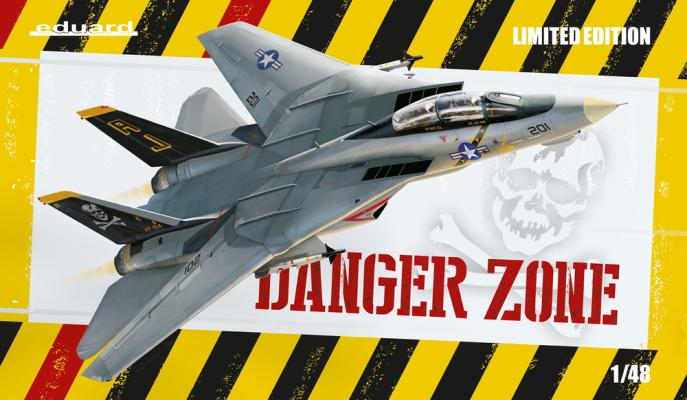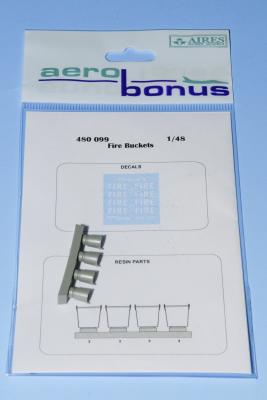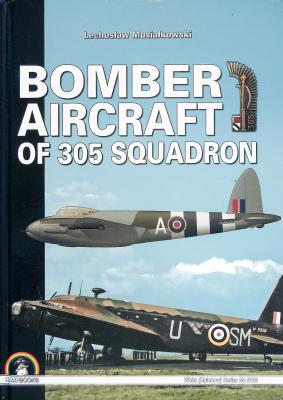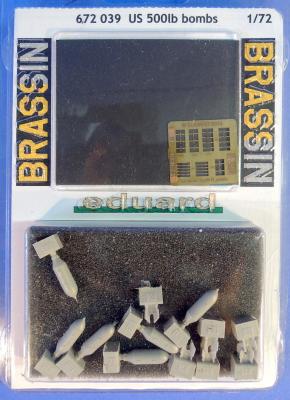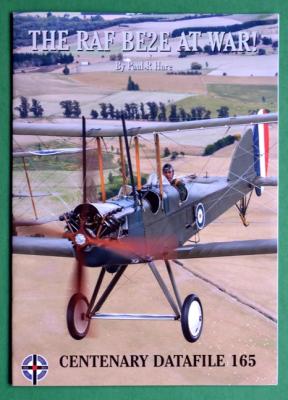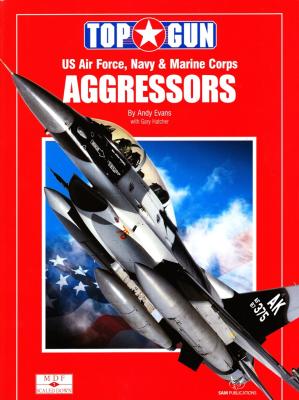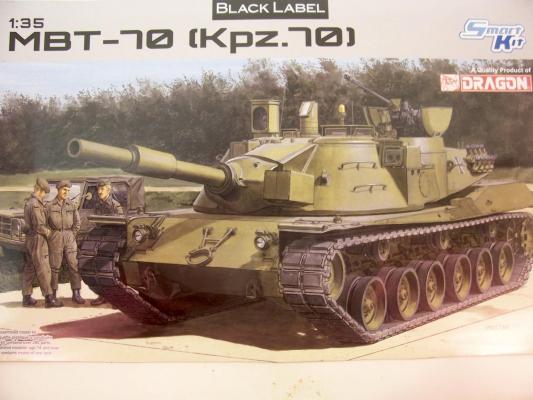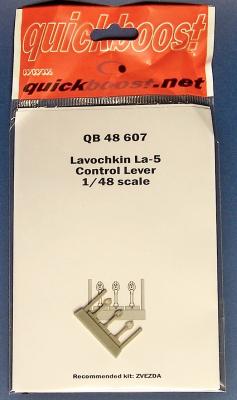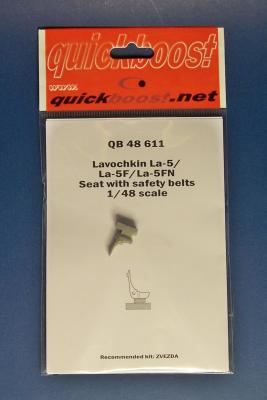Eduard’s “Danger Zone” release of the Hobby boss 1/48 F-14A with resin, Photoetch, and canopy mask embellishment, is a great package. Here’s why I think so:
What's New
A perfect addition to your diorama or display base is this Aires Aerobonus fire bucket set. Aires Aerobonus provides you with four resin fire buckets and a set of decals: “Fire”. Of note is the re-sealable packaging that Quickboost uses that makes the parts easy to review and then stuff back into the package securely. The supplied instructions provide color and decal placement drawings.
Aires Aerobonus has molded the fire buckets in light grey resin with no bubbles that I could find. There are no mold seams to sand off and the resin plug is easily removed from the bottom with a razor saw or Dremel. Use care in removing the plug resin plug though as the bucket bottom is quite thin (ask me how I know). Also be very careful with the handle tabs. They are quite thin as well and will require a light touch when drilling a hole for the handle.
Bomber Aircraft of 305 Squadron is a photographic history of the 305 Weilkopolski Polish bomber squadron. The book is dedicated to Gabriel Milosz, who served as a photographer for the 305 squadron from its formation until its disbandment. Milosz's photographs capture the aircraft used by the 305 Squadron as well as the crews before and after the, often tragic, missions. He also captured the mechanics, armorers, and daily life of the Polish squadron. The photographs are black-and-white, while the illustrated aircraft profiles are in full-color.
From the back of the book:
This is the illustrated history of the aircraft of the successful Polish bomber squadron flying for the RAF during WWII. No. 305 'Weilkopolski' squadron was a Polish bomber squadron, which originally served is a night bomber squadron, then in 1943 converted to daylight operations, and ended the war is a low-level specialist bomber squadron.
The kit includes six resin bombs, resin tailfins, photoetch for the nose fuse and rear arming vanes, 1 decal sheet, and instructions.
I compared the Brassin bomb to a 500 lb. bomb from Revell’s B-17F Memphis Belle. The two bombs are very close in size and shape, however the Brassin bomb has much thinner tail fins and greater detail with the flanges on each of the fins. The nose fuse on the Brassin bomb has a more accurate projection, and the suspension lugs have nice definition. The Revell bomb only includes a slot for attachment without the suspension lugs. The rear arming vanes on the Brassin bomb are obviously much greater detail, as they are not included with the Revell bomb. The Brassin bomb has only very slight mold seams, which are easily corrected, compared to the larger glue joint and sprue attachments on the Revell bomb that need more extensive cleanup.
To coincide with the display in the UK of two airworthy BE2E reproductions from New Zealand's TVAL earlier this year, Albatros Productions fortunately decided that Centenary Datafile 165 would continue telling the story of the first WWI British two-seater to see action in the Great War. This Datafile picks up where the story left off in Centenary Datafile 163, giving a chronological account of the sequential development of the BE2/BE2A/BE2B versions into the up-powered E version. Paul Hare (who also authored Datafile 163, devoted to covering the BE2/BE2A/BE2B versions) authored this well-researched and heavily illustrated monograph. Hare has made a special study of Royal Aircraft Factory designs in WWI and is recognized for his knowledge of the BE2 type.
Do you have an interest in aircraft that are used in dissimilar air combat training? Not familiar with that term? I bet you are familiar with aggressor aircraft though and the squadrons. This book takes an in depth look at the aircraft flown by USAF, USN and USMC. The book is chocked full of color photographs and color plate drawings.
The book obviously starts with the beginnings of the aggressor squadrons. This occurred during the Vietnam War when the losses to US aircraft became unacceptable and the USAF and USN looked into how they could better prepare their aircrews for combat. Thus the creation of "Top Gun" for the USN and "Red Flag" for the USAF. For these two programs, the best of the best pilots were selected and they learned to fly the tactile doctrines of the Soviet Union.
Kit
This is another of Dragons “Black Label” kits. The model is boxed in a sturdy box with a nice painting showing the vehicle used in West German markings. Inside you will find seven spruces molded in grey plastic. Also one clear spruce, lower hull section, four Dragon DS track links, small decal sheet, instruction fold out sheet, and a photo reference sheet with photos of a vehicle at the famous Deutsches Panzermuseum Munster located in Germany. The parts are flash free with some mold lines that clean up very well. Dragon includes a correction instructions sheet for step 15. The correction is a simple one in that all is needed is to cut off a piece of a part and glue it in a different area. The parts count is just right and I found that there are only two parts left over after the build - something that I’m not used to with a Dragon kit as my parts box usually gets stuffed after a Dragon kit build. No PE fret is included in the kit.
When the name John Vojtech is mentioned in the Modeling community, one of the first things that comes to mind if you are familiar with him is the level of detail usually associated in his models. Through John's desire for a higher level of detail he has created his own tool line to make it easier for modelers to achieve this level in their own models.
The Mini Punch and Die set is made with hardened steel and will allow you punch plastic and metal discs in sizes of 0.6, 0.8, 1.0, 1.2, 1.4 and 1.6. I found the punches to be very sharp so you don't have to apply a lot of pressure and makes a nice clean cut. This set is great for adding those little details found in many different types of models.
The Zvezda kit has been out for few years now and it is without a doubt the best La-5 in 1/48 scale. Surprisingly, the folks at Aries/Quickboost have been busy creating resin upgrades specifically for it. Releasing new items this late in the game is a testament to the kits potential. I’ve had my kit for a while now waiting to perform an all out super build. I’ve collected a few goodies; mainly Eduard aftermarket sets, flaps and such, and needless to say when I spotted new items from Aires’s Quickboost line for it I offered to review all of them. Besides the control levers I also received the Quickboost La-5FN seat with safety belts #QB48 611 and from Aires the La-5FN cockpit set #4629 to review. Since the Aires cockpit set offers basically the same control lever I will be using that one. However as you can see in the photographs with the Quickboost offering you get 3 identical levers.
Just what the doctor ordered, a new seat for the Zvezda kit. The Zvezda kit offers an excellent cockpit, engine and everything else. It’s an awesome kit but its weakest point is the seat. The folks at Quickboost have come to the rescue with this excellent casting that includes safety belts. Besides this seat being overwhelmingly superior to the kit part, I will be using this seat over the Aires seat provided in the Aires cockpit set #4629. Personally I prefer a seat with well-molded seat belts to the photo-etch ones. As you can see in the photographs it’s a must have if you plan on building any of Zvezda’s La-5/LA-5F/LA-5FN and it should work with any La-5 kits available.
Bottom Line
I recommend this part for your next La-5 build and would like to thank; Quickboost, Aires and IPMS for the opportunity to present this piece to my fellow IPMS brothers and sisters.

